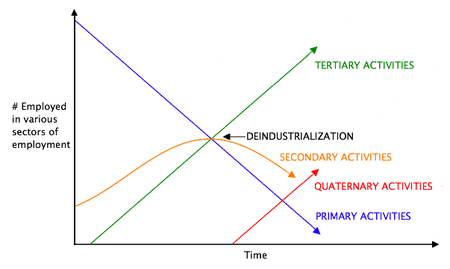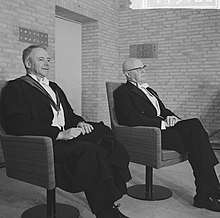Colin Clark (economist)
Colin Grant Clark (2 November 1905 – 4 September 1989) was a British and Australian economist and statistician who worked in both the United Kingdom and Australia. He pioneered the use of gross national product (GNP) as the basis for studying national economies.
Colin Clark | |
|---|---|
.png) | |
| Born | 2 November 1905 London, England |
| Died | 4 September 1989 (aged 83) Brisbane, Australia |
| Nationality | British/Australian |
| Alma mater | Oxford University |
| Scientific career | |
| Fields | Economics |
| Institutions | Oxford University, Cambridge University, Monash University, University of Queensland |
| Doctoral students | Sir Richard Stone V.K.R.V. Rao Sir Alexander Cairncross Hans Singer |
| Influenced | Angus Maddison |
| Economic sectors |
|---|
| Three-sector model |
|
Primary sector: raw materials Secondary sector: manufacturing Tertiary sector: services |
| Additional sectors |
|
Quaternary sector: information services Quinary sector: human services |
| Theorists |
| AGB Fisher · Colin Clark · Jean Fourastié |
| Sectors by ownership |
| Business sector · Private sector · Public sector · Voluntary sector |
Early years
Colin Clark was born in London in 1905 and was educated at the Dragon School in Oxford. He then studied at Winchester College, then at Brasenose College, Oxford[1] where he graduated in Chemistry in 1928. After graduation he worked as a research assistant with William Beveridge at the London School of Economics (1928–29) and then with Sir Alexander Carr-Saunders and Allyn Young at the University of Liverpool (1929–30). During this time he ran unsuccessful campaigns to be elected to parliament for the British Labour Party in the seat of North Dorset (1929), and later for Liverpool Wavertree (1931) and South Norfolk (1935).
In 1930 he was appointed a research assistant to the National Economic Advisory Council newly convened by Prime Minister Ramsay MacDonald. He resigned shortly after his appointment, after being asked to write a background memorandum to make a case for protectionism. Despite this, he had sufficiently impressed one of the council members (John Maynard Keynes) to secure an appointment as a lecturer in statistics at Cambridge University.
Lecturer at Cambridge
He was a lecturer in Statistics in Cambridge from 1931 to 1938 where he completed three books: The National Income 1924–31 (1932), The Economic Position of Great Britain (jointly with A.C Pigou) (1936) and National Income and Outlay (1937). His first book was sent to the publisher Daniel Macmillan with a recommendation from Keynes: "[...] Clark is, I think, a bit of a genius: almost the only economic statistician I have ever met who seems to me quite first-class."[2]
Move to Australia

During a visit to Australia and New Zealand in 1937 and 1938 he accepted a position with the Queensland Government at the invitation of the premier Forgan Smith.[3] At the time he wrote to Keynes about his decision to stay in Australia. As he put it, the chance to advise the Queensland Premier on 'practically everything connected with economic matters' was 'too remarkable an opportunity to be missed for putting economics into practice'[4]
On 6 May 1938, he was appointed Government Statistician, Director of the Bureau of Industry, and Financial Advisor to Queensland Treasury, and provided the State's first set of economic accounts in 1940. He also held the position of Deputy Director (Queensland) of the Commonwealth Department of War Organisation of Industry from 1942 to 1946. Clark resigned as Government Statistician on 28 February 1947 to become Under Secretary of the Queensland Department of Labour and Industry.[5]
Unusually for a public servant he continued his academic work, publishing numerous articles in Economics and preparing his book "Conditions of Economic Progress" which was published in 1940.
Later years


In 1951 he took a secondment to the Food and Agriculture Organization in Rome (1951) and then to the University of Chicago (1952) before taking the Directorship of the Institute for Agricultural Economics at Oxford University (1952–69). He returned to Australia in 1969 as the Director of the Institute of Economic Progress at Monash University (1969–78) and finally as a Research Consultant to the Department of Economics at the University of Queensland until his death in 1989.
He was on the Council of the Econometric Society from 1948 to 1952.[6]
Family
Clark married Marjorie Tattersall in 1935, and they had 8 sons and 1 daughter who in turned produced a total of 50 grandchildren. His son Gregory became an author and academic in Japan. His nephew is the cognitive psychologist and computer scientist Geoffrey Hinton.
Marjorie's sister (that is Clark's sister-in-law), Viva Tattersall was a stage actress and Hollywood movie star.
Death
Clark died in Brisbane, Australia in 1989. He is buried together with his wife Marjorie at the Mount Gravatt Cemetery in Brisbane (Section 3B).[7]
Accolades
In 1984 he was named by the World Bank as one of the pioneers of development along with Sir Arthur Lewis, Gunnar Myrdal, W.W. Rostow and Jan Tinbergen.[8]
In 1987 Clark was together with Professor Trevor Swan the first recipient of the Distinguished Fellow awards, presented by The Economic Society of Australia.[9]
Honours
- Fellow of the Econometric Society .
- Corresponding Fellow of the British Academy.
- Distinguished Fellow Award, The Economic Society of Australia.
- HonDEcon Tilburg University , DLitt Oxford University, HonDSc University of Milan, Hon DEcon, Monash University, HonDEcon University of Queensland.
- The Australasian Meeting of the Econometric Society has a Colin Clark Lecture at its meetings.
- A building at the University of Queensland is named for him, and it is reputed that a stone grotesque in the University's Great Court was also made in his likeness (G19).[10]
Publications
Papers
- "A System of Equations Explaining the United States Trade Cycle, 1921 to 1941," Econometrica, Vol. 17, No. 2 (Apr. 1949), pp. 93–124.
- "The Economic Functions of a City in Relation to Its Size," Econometrica, Vol. 13, No. 2 (Apr. 1945), pp. 97–113.
- "Economic Development in Communist China," The Journal of Political Economy, Vol. 84, No. 2 (Apr. 1976), pp. 239–264.
- "Theory of Economic Growth," Econometrica, Vol. 17, Supplement: Report of the Washington Meeting (Jul. 1949), pp. 112–116.
- "The Measurement of National Wealth: Discussion," (with Milton Gilbert; J. R. N. Stone; Francois Perroux; D. K. Lieu; Evelpides; Francois Divisia; Tinbergen; Kuznets; Smithies; Shirras; MacGregor), Econometrica, Vol. 17, Supplement: Report of the Washington Meeting. (Jul. 1949), pp. 255–272.
- "A Critique of Russian Statistics by Colin Clark," Economica, May 1941, NS 8, p. 212.
- "Russian Income and Production Statistics," The Review of Economics and Statistics, Vol. 29, No. 4 (November 1947), pp. 215–217.
- "Afterthoughts on Paley," The Review of Economics and Statistics, Vol. 36, No. 3 (Aug. 1954), pp. 267–273.
- ""Mr. Colin Clark on the Limits of Taxation": A Rejoinder," The Review of Economics and Statistics, Vol. 36, No. 1 (February 1954), p. 101.
- "The New Board of Trade Indexes," The Economic Journal, Vol. 45, No. 178 (Jun. 1935), pp. 370–375.
- "Determination of the Multiplier from National Income Statistics," The Economic Journal, Vol. 48, No. 191 (September 1938), pp. 435–448.
- "Public Finance and Changes in the Value of Money," The Economic Journal, Vol. 55, No. 220 (December 1945), pp. 371–389.
- "Further Data on the National Income," The Economic Journal, Vol. 44, No. 175 (September 1934), pp. 380–397.
- "The Value of the Pound," The Economic Journal, Vol. 59, No. 234 (Jun. 1949), pp. 198–207.
- "National Income at Its Climax," The Economic Journal, Vol. 47, No. 186 (Jun. 1937), pp. 308–320.
- "World Supply and Requirements of Farm Products," Journal of the Royal Statistical Society, Series A (General), Vol. 117, No. 3 (1954), pp. 263–296
- "Future Sources of Food Supply: Economic Problems," Journal of the Royal Statistical Society, Series A (General), Vol. 125, No. 3 (1962), pp. 418–448
- "Urban Population Densities," Journal of the Royal Statistical Society, Series A (General), Vol. 114, No. 4 (1951), pp. 490–496
- "The National Income and The Net Output of Industry," Journal of the Royal Statistical Society Vol. 96, No. 4 (1933), pp. 651–659
Books
- The National Income, 1924–31, 1932.
- The Economic Position of Great Britain, with A.C.Pigou, 1936.
- National Income and Outlay, 1937.
- A Critique of Russian Statistics, 1939.
- Conditions of Economic Progress, 1940.
- The Economics of 1960, 1942.
- Statistical Society
- Australian Hopes and Fears, 1958
- Growthmanship, 1961.
- Economics of Subsistence Agriculture, with M.R. Haswell, 1964.
- Population Growth and Land Use, 1967.
- Starvation or Plenty?, 1970.
- The Myth of over Population and Why Population Growth Could Be Desirable June 1975.
- Poverty Before Politics, 1977.
- The Economics of Irrigation with J. Carruthers, 1981.
- Regional and Urban Location, 1982.
References
- The college retains a small collection of his papers http://www.bnc.ox.ac.uk/downloads/bnc_society/autumn07edition.pdf
- Don Patinkin, "Keynes and Econometrics: On the Interaction between the Macroeconomic Revolutions of the Interwar Period," Econometrica, Vol. 44, No. 6 (November 1976), pp. 1091–1123
- Clark named his second son Nicholas Forgan in recognition of Smith's offer
- "03_Colin_Clark_speech". archive.treasury.gov.au.
- http://www.oesr.qld.gov.au/queensland-by-theme/society/bulletins/q150-stats-stories/gov-stats-qld/gov-stats-qld.pdf%5B%5D
- "Archived copy". Archived from the original on 13 December 2007. Retrieved 11 February 2008.CS1 maint: archived copy as title (link)
- Kenwood, A. G. "Clark, Colin Grant (1905–1989)". Australian Dictionary of Biography. National Centre of Biography, Australian National University – via Australian Dictionary of Biography.
- Peters, G. "Colin Clark (1905–89) Economist and Agricultural Economist," QEH Working Paper Series, Working Paper Number 69, April 2001
- "All About Us". esacentral.org.au.
- "A guide to the Great Court". 1 January 1992. Cite journal requires
|journal=(help)
External links
- Don Patinkin, "Keynes and Econometrics: On the Interaction between the Macroeconomic Revolutions of the Interwar Period," Econometrica, Vol. 44, No. 6 (November 1976), pp. 1091–1123
- Pioneers in Development Meier, G.M. and Seers, D. (eds) 1984, Oxford: Oxford University Press for the World Bank
- Macromeasurement Before and After Colin Clark, by Angus Maddison, an extended version of the Colin Clark Lecture, delivered at the University of Queensland, 22 August 2003.
- Australian Dictionary of Biography
- Colin Clark as a development economist H.W. Arndt. (Subscriber site)
- Donald Markwell, Keynes and Australia, Reserve Bank of Australia, 2000; pages 39–43 especially relate to Colin Clark.